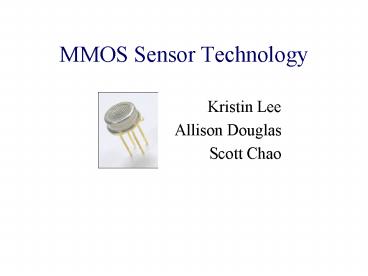MMOS Sensor Technology - PowerPoint PPT Presentation
1 / 11
Title:
MMOS Sensor Technology
Description:
MMOS Sensor Technology. Kristin Lee. Allison Douglas. Scott Chao ... R = (L/A) For p-type semiconductors ... John Wiley & Sons, Inc. 1999. City Technology. ... – PowerPoint PPT presentation
Number of Views:41
Avg rating:3.0/5.0
Title: MMOS Sensor Technology
1
MMOS Sensor Technology
- Kristin Lee
- Allison Douglas
- Scott Chao
2
Mixed Metal Oxide Semiconductor (MMOS)
- When surface absorbs gas, there is a large change
in electrical conductivity - Commonly used oxides
- Cr2TiO3
- WO3
- SnO2
3
Oxidizing and Reducing Gases
- Change in resistance caused by loss or gain of
surface electrons - Absorbed oxygen reacts with target gas
- Reducing gases
- Donate electrons and decrease hole concentration
- CO, CH4
- Oxidizing gases
- Accept (subtract) electrons and increase hole
concentration - NO2, O3
4
Semiconductor Types
- n-type semiconductor
- Electrons are majority carrier
- Electron concentration (n) of conduction band
affected by gas - p-type semiconductor
- Holes are majority carrier
- Hole concentration (p) of valence band affected
by gas
5
Energy Band Diagram
- Ec corresponds to the potential energy of the
electron at rest - Kinetic energy of an electron is measured upward
from the conduction band - Ev corresponds to the potential energy of the
hole at rest - Kinetic energy of a hole is measured downward
from the valence band
6
Semiconductor Resistivity
- Resistivity, ? 1/(q?nn q?pp)
- q 1.6x10-19 C
- ?n,p electron, hole mobility (cm2/V-s)
- n electron concentration
- p hole concentration
- For n-type, ngtgtp, ? ?1/(q?nn)
- For p-type, pgtgtn, ? ?1/(q?pp)
7
MMOS Ozone Sensors
8
MMOS Ozone Sensors
- Heated
- Reduces interference from humidity
- Increases response time
- Gas selectivity optimization
- Oxide microstructure and thickness
- Catalytic additives to oxide
- Protective coatings
- Activated-carbon filters
9
MMOS Ozone Sensors
- O3 is an oxidizing gas (i.e. reduces electron
concentration) - Recall, for n-type semiconductors
- ? ?1/(q?nn)
- As n decreases, ? will increase, and therefore
resistance increases - R ?(L/A)
- For p-type semiconductors
- ? ?1/(q?pp)
- As p increases, ? and R decrease
10
MicroChemical Systems Ozone Sensor
- RS determined by voltage division
- VS VCC(RS/(RL RS)
- VSRL VSRS VCCRS
- RS (RL/(VCC - VS))VS
- As O3 concentration increases,
- VS increases and RS increases. Therefore, the
MiCS sensors are n-type semiconductors.
11
Resources
- Casey, H. Craig Jr. Devices for integrated
Circuits Silicon and III-IV Compound
Semiconductors. John Wiley Sons, Inc. 1999. - City Technology. http//www.citytech.com/technolog
y/semiconductors.asp - Massoud, Hisham Z. Class notes for ECE 216,
Department of Electrical and Computer
Engineering, Duke University. - MicroChemical Systems. Datasheet for MiCS-2610
Ozone Sensor.










![Industry Forecast on Global 3D Sensor Market [2014-2022] PowerPoint PPT Presentation](https://s3.amazonaws.com/images.powershow.com/8309646.th0.jpg?_=20151203055)




















